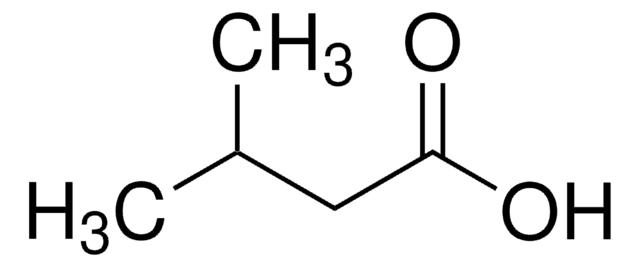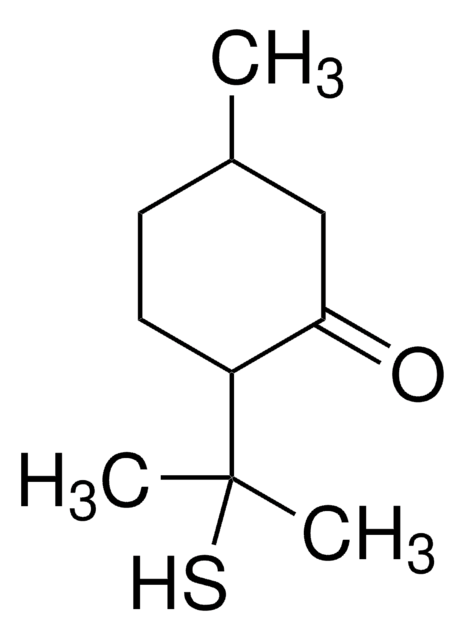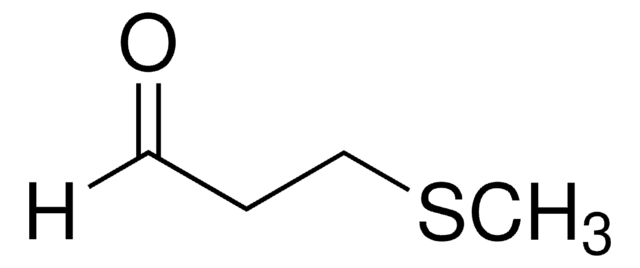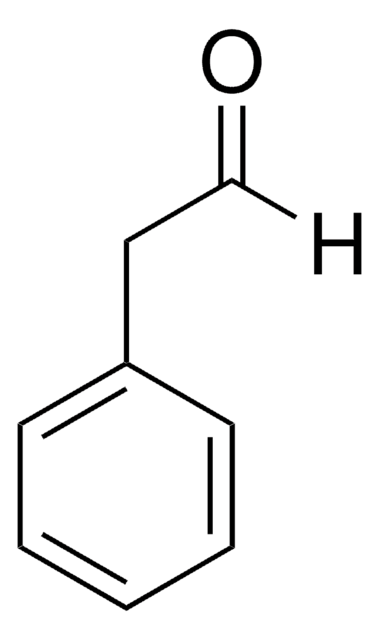Key Documents
W269212
Isovaleraldehyde
natural, ≥95%, FG
Synonim(y):
3-Methylbutanal, 3-Methylbutyraldehyde, NSC 404119
About This Item
Polecane produkty
klasa czystości
FG
Fragrance grade
Kosher
natural
Poziom jakości
agency
follows IFRA guidelines
meets purity specifications of JECFA
zgodność regionalna
EU Regulation 1223/2009
EU Regulation 1334/2008 & 178/2002
FDA 21 CFR 117
gęstość pary
2.96 (vs air)
ciśnienie pary
30 mmHg ( 20 °C)
Próba
≥95%
temp. samozapłonu
464 °F
charakterystyka ekologicznej alternatywy
Less Hazardous Chemical Syntheses
Use of Renewable Feedstocks
Learn more about the Principles of Green Chemistry.
sustainability
Greener Alternative Product
współczynnik refrakcji
n20/D 1.388 (lit.)
tw
90 °C (lit.)
gęstość
0.803 g/mL at 25 °C (lit.)
Zastosowanie
flavors and fragrances
Dokumentacja
see Safety & Documentation for available documents
alergen pokarmowy
no known allergens
alergen zapachowy
no known allergens
kategoria ekologicznej alternatywy
, Aligned
Organoleptyczne
chocolate; fruity; ethereal; peach; sour
ciąg SMILES
[H]C(=O)CC(C)C
InChI
1S/C5H10O/c1-5(2)3-4-6/h4-5H,3H2,1-2H3
Klucz InChI
YGHRJJRRZDOVPD-UHFFFAOYSA-N
Szukasz podobnych produktów? Odwiedź Przewodnik dotyczący porównywania produktów
Opis ogólny
Zastosowanie
- Contribution of phospholipase B to the formation of characteristic flavor in steamed sturgeon meat.: This study discusses how phospholipase B contributes to flavor formation in steamed sturgeon, including the role of isovaleraldehyde in enhancing sensory attributes, potentially applicable for food chemistry and biochemistry research (Yang Z et al., 2024).
- Catalytic hydroboration of aldehydes and ketones with an electron-rich acyclic metallasilylene.: This research explores the catalytic activity of metallasilylene complexes in the hydroboration of aldehydes, including isovaleraldehyde, highlighting its significance in synthetic chemistry and materials science (Kapp L et al., 2024).
- Effects of Storage in an Active and Spontaneous Controlled O(2)/CO(2) Atmosphere on Volatile Flavor Components and the Microbiome of Truffles.: This article examines how controlled atmospheric conditions affect the volatile profile of truffles, including isovaleraldehyde, providing insights into food preservation techniques and microbiome interactions (Li Q et al., 2024).
- GC-MS, GC-IMS, and E-Nose Analysis of Volatile Aroma Compounds in Wet-Marinated Fermented Golden Pomfret Prepared Using Different Cooking Methods.: Investigates how cooking methods impact the aroma profile of marinated pomfret, with a focus on isovaleraldehyde as a key volatile compound, relevant for studies on food quality and sensory analysis (Chen Q et al., 2024).
Hasło ostrzegawcze
Danger
Zwroty wskazujące rodzaj zagrożenia
Zwroty wskazujące środki ostrożności
Klasyfikacja zagrożeń
Aquatic Chronic 2 - Eye Irrit. 2 - Flam. Liq. 2 - Skin Sens. 1 - STOT SE 3
Organy docelowe
Respiratory system
Kod klasy składowania
3 - Flammable liquids
Klasa zagrożenia wodnego (WGK)
WGK 2
Temperatura zapłonu (°F)
32.9 °F - closed cup
Temperatura zapłonu (°C)
0.5 °C - closed cup
Środki ochrony indywidualnej
Eyeshields, Faceshields, Gloves, type ABEK (EN14387) respirator filter
Wybierz jedną z najnowszych wersji:
Masz już ten produkt?
Dokumenty związane z niedawno zakupionymi produktami zostały zamieszczone w Bibliotece dokumentów.
Klienci oglądali również te produkty
Nasz zespół naukowców ma doświadczenie we wszystkich obszarach badań, w tym w naukach przyrodniczych, materiałoznawstwie, syntezie chemicznej, chromatografii, analityce i wielu innych dziedzinach.
Skontaktuj się z zespołem ds. pomocy technicznej

















